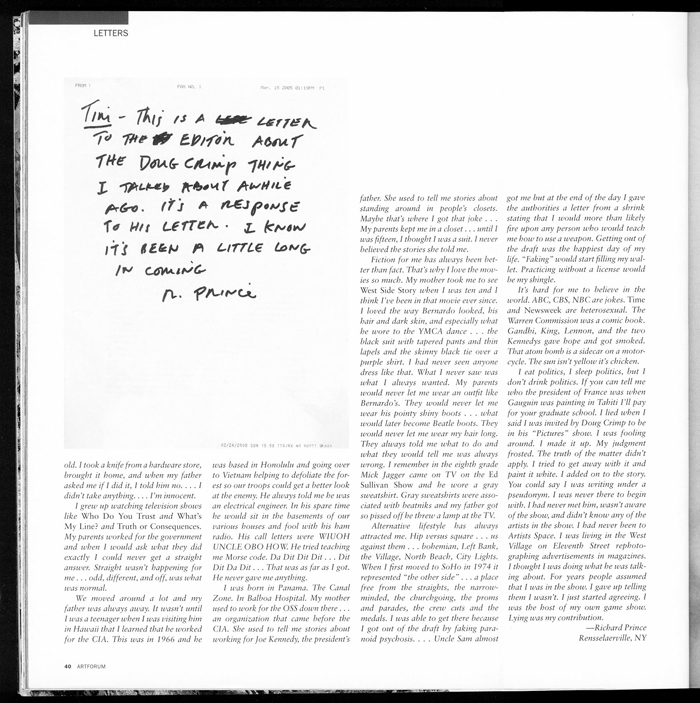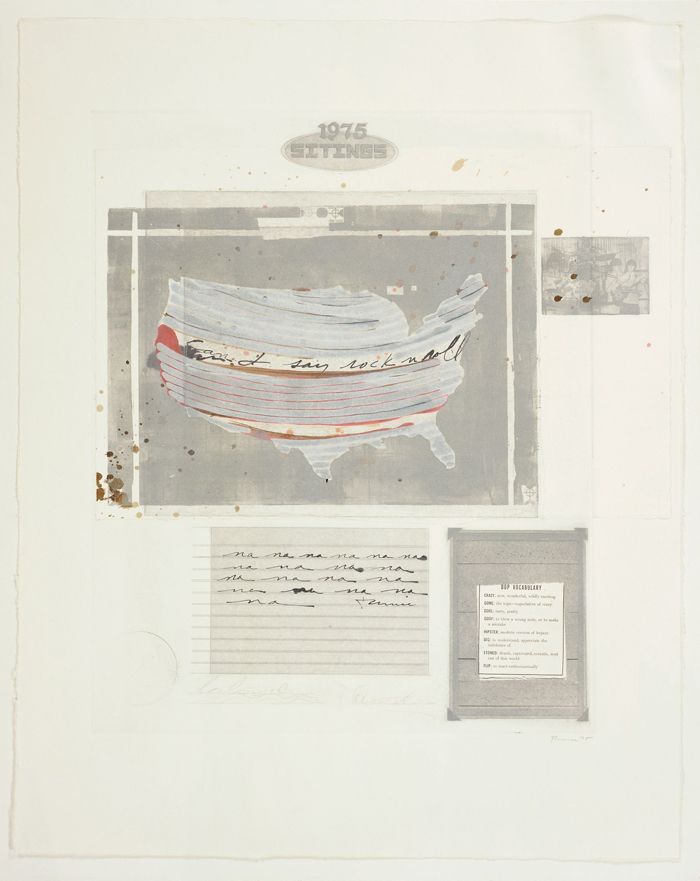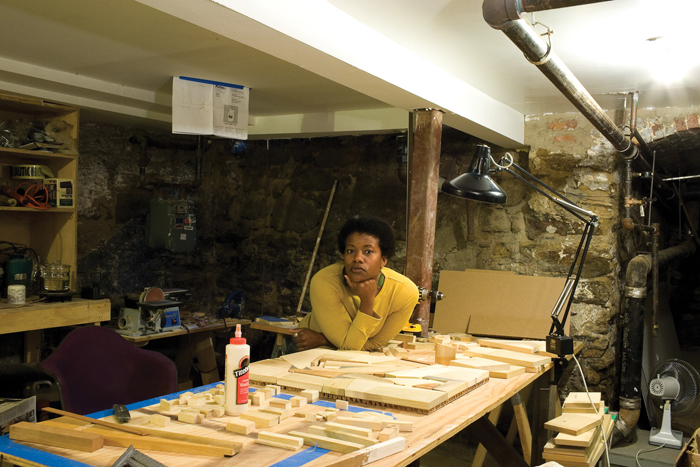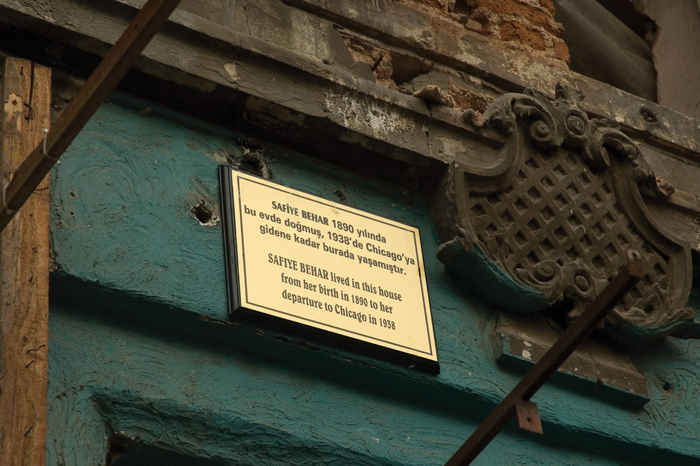I either say what I think, or the opposite of what I think. And hopefully the absolute power of both transcends.
–Sarah Silverman, New York Times Oct. 3, 2008For the essence of bullshit is not that it is false but that it is phony.
–Harry G. Frankfort, On Bullshit, 2005The parafictional mobilizes two contradictory assumptions in traditional understandings of aesthetic: that art reveals truth, and that art is a space apart from reality.
–Carrie Lambert-Beatty, Make-Believe: Socially-Engaged Art and the Aesthetic of the Plausible, 2008I don’t believe in hypotheticals. It’s like lying to your brain.
–Kenneth, 30 Rock, NBC
The 2008 summer issue of Artforum printed a letter from Richard Prince that began with these sentences: “Paint it white. I am a Liar. And I cheat too. I make things up and I can’t be trusted.” This letter was in response to a letter written to Artforum by Douglas Crimp in 2003 that refuted Prince’s claim in a 2003 Artforum interview that Crimp invited him to participate in the historically pivotal Pictures exhibition at Artists Space in 1977. Five years later in the pages of the same magazine, Prince confessed, “I lied when I said I was invited by Doug Crimp to be in his Pictures show. I was fooling around. I made it up.”1

Lying is not new to Prince’s identity construction. Founding his career on blunt acts of appropriation—first collage and then photography—Prince vigorously exploits the fundamentals of truth. He chips away at veracity and all its virtuous qualities by serving up collections of re-photographed images—an analytical practice bereft of unique style and artistic expression. “He has said that his goal is ‘a virtuoso real,’ something beyond real that is patently fake,” wrote Roberta Smith for the New York Times.2 Irrefutably, this fakeness is characteristic not only of his art but of the artist himself. “No one really knows Richard’s biography,” states Nancy Spector, organizer of Richard Prince: Spiritual in America at the Guggenhiem Museum in 2007. “There are all these stock lines and lies; they’ve been there since the beginning.”3
In a 2007 exhibition titled Fugitive Artist: The Early Work of Richard Prince, 1974-77, at the Neuberger Museum of Art in Purchase, New York, art history professor Michael Lobel assembled a collection of approximately 50 early text and image collages that are not included in Prince’s historically endorsed oeuvre. “What makes this show especially interesting,” writes critic Benjamin Genocchio, “is that much of Mr. Prince’s early work is absent from published accounts of his evolution as an artist. The reasons for this are not entirely clear, though Mr. Lobel speculates in the catalog that it is part of an effort by the artist to expunge this part of his career, along with the figurative and photo-text work he then favored. Artists have long been attentive to the way their career narratives are shaped, and Mr. Prince appears to be especially sensitive in this regard.”4 So much so that Prince and his New York gallerist, Barbara Gladstone, refused to assist Lobel in the making of this exhibition. Prince also prohibited Lobel from reproducing images of any of the work in the exhibition. Prince’s disallowance of these vulnerable and immature early works contributes to the perception of his preoccupation with identity construction. Ironically, by perpetuating the myth that his photographic appropriations were birthed anew, without any awkward preliminary investigations into cut and paste deconstruction strategies, he undercuts the critical impact of the photographic work, reinforcing Modernism’s concern with originality and genius.
Prince’s fabrication of artistic identity also seems to have extended to the construction of an alias. The pseudonymous ‘80s artist John Dogg is rumored to be Richard Prince, invented in collaboration with dealer Colin de Land. The following is a maundering exchange between Prince (“Me”) and John Dogg that exposes shared interests in car culture, jokes and self-involvement. The interview begins with a disclaimer by Prince stating, “This text piece has been done without the cooperation of John Dogg.” Prince goes on to say “Dogg’s passages are transcribed from recorded conversations between him and the author from March 1985 to approximately June of the same year.”
Me: John called one of his tire pieces Creative Evolution. He said he had seen the name “illustrated” on the door of one of those monster trucks, the ones with the huge wheels, a truck that one usually sees on top of an old car, crushing that car’s roof as it makes its way forward onto the next old car. Creative Evolution he said was a perfect name for such a truck. A perfectly comic name. Perfectly comic because one usually laughs when one compares two similar faces neither of which has a comic effect by itself. When one finds such repetitive faces, one usually suspects some queer mechanism lying behind the faces, like the faces appear to be “living things.” And according to our expectations, “what is living” should never be repeated exactly the same. And what John ultimately thought the joke was behind the name (behind the face) was that the relationship of the truck driver’s brain to the mass of the truck looked pretty much the same as the relationship of the brain of a dinosaur to the mass of the dinosaur’s body.
John: A lot of thumping of chests and breasts in the ‘80s art world. Heroes and heroines, artists with all kinds of private points of view, living in apartments, living in castles, living on the beaches and in forests. They have their portraits taken. Hans Namuth, ‘50s style. Looking like Abstract Expressionists and Method actors. They look great in their portraits. Serious and believable. They never come across looking at all what they really are in real life. Good portraits. I don’t know how they do it. I feel like I’m in a mobile home at a rest stop on Highway 95 North, somewhere around Stamford, Connecticut, on the phone talking to Vogue…. Listen, I’m hung up here, traffic’s so heavy, too late to step on it, looks like I won’t be getting my picture taken today. Huh? What? Sure I want to be remembered, thought about, we all do. Yeah, well, what can I say? Next time. Jesus, you know, I can’t seem to bring my self to make the who’s who connection. The “bringing” just doesn’t figure in except as a hang-up. Why the resistance? I can’t explain it. Can’t guess it. Me to the ‘80s art world, I feel, I don’t know, AWOL.5

Prince is a head-game artist. The inane interview with Dogg is an illustration of his grandiose self-interest. He lies and deceives but he holds the truth in high regard. Prince is a complex and even corrupt personality but he is not a bullshitter. His continuous and varied assaults on truth are not intended to develop elaborate fictions or to propagate artistic hoaxes; instead, Prince undercuts truth in order to examine its principled authority. In 2005, Harry G. Frankfort, a moral philosopher and Professor Emeritus at Princeton University wrote a small tome called On Bullshit. His thesis is that bullshitting is more dangerous than lying because in order to lie one has to know that the truth is a simple and beautiful postulate that allows for play, imagination and critique within the categories of truth, falsehood and bullshitting.
Of lying, Frankfort asserts, “Telling a lie is an act with a sharp focus. It is designed to insert a particular falsehood at a specific point in a set or system of beliefs, in order to avoid the consequences of having that point occupied by the truth. This requires a degree of craftsmanship, in which the teller of the lie submits to objective constraints imposed by what he takes to be the truth. The liar is inescapably concerned with truth-values. In order to invent a lie, he must first think he knows what is true. And in order to invent an effective lie, he must design his falsehood under the guidance of truth.”6
Truth has always been Prince’s subject and obsession. In an early interview from 1982 with Barbara Kruger, he evokes the unnaturalness of telling the truth.
Richard Prince: At first it was pretty reckless. Re-photographing someone else’s photograph, making a new picture effortlessly. Making the exposure, looking through the lens and clicking, felt like an unwelling…a whole new history without the old one. It absolutely destroyed any associations I had experienced with putting things together. And of course the whole thing about the naturalness of the film’s ability to appropriate. I always thought it had a lot to do with having a chip on your shoulder.
Barbara Kruger: What about now?
RP: Now it’s harder to talk about. Appropriation had a lot to do with being faithful…beating yourself up really. Now it’s become more sophisticated, more adulterated. I have this feeling the pictures I’m taking look like they’ve been sent away for… you know? Like Battle Creek, Michigan. I don’t know how else to put it.
RP: What about all these recorded conversations we hear about these days?
BK: Presidents, interview, things like that?
RP: Yes.
BK: Well, in most cases recording seems to offer both the curiosity of replication and the resoluteness of evidence.
RP: Does this have anything to do with the pictures we’re looking at?
BK: Yes. I think in some ways their definitions are interchangeable.
RP: Fiction feels good and recanting causes stress. Like lying, in the physiological sense, the telling of a true story is an unnatural act. Do you think fiction has anything to do with replication?
BK: Pictures and words seem to become the rallying points for certain assumptions. There are assumptions of truth and falsity and I guess the narratives of falsity are called fictions. I replicate certain words and watch them stray from or coincide with the notions of fact and fiction.7
Truth and falsity are opponents in the same game. Taking the side of the lie, Prince has regularly employed it as a crafty and effective form of critique. The truths shoring up notions of originality, authenticity, and imagination have always been his target. Prince has made a career defying the authority of truth and refusing to meet its uncompromising demands by simply re-presenting it. The truth is too important to Prince for him to be a mere bullshitter.
“On the other hand,” writes Frankfort, “…a person who undertakes to bullshit his way through has much more freedom. His focus is panoramic rather than particular. He does not limit himself to inserting a certain falsehood at a specific point, and thus he is not constrained by the truths surrounding that point or intersecting it. He is prepared, so far as required, to fake the context as well. This freedom from constraints to which the liar must submit does not necessarily mean, of course, that his task is easier than the task of the liar. But the mode of creativity upon which it relies is less analytical and less deliberative than that which is mobilized in lying.”8

With all of this freedom from truth, bullshitting is not a medium promoted by artists. Forms of falseness held in check by truth are common vehicles for the artistic imagination and critical commentary. Fiction, truthiness, hoaxes, pseudonyms and satire are prevalent in contemporary art. Joe Scanlan’s alias Donelle Woolford, a female African American artist, Bernadette Corperation’s made-up New York art dealer, Reena Spaulings, and Fae Richards, an African American film star invented by artist Zoe Leonard and filmmaker Cheryl Dunye, are examples of fictional character constructions whose ancestry goes back to Duchamp’s Rrose Sélavy.
Michael Blum’s project for the 9th Istanbul Biennial, titled A tribute to Safiye Behar (2005), is an example of a tactical lie, a truth-bending practice that art historian Carrie Lambert calls the parafictional. For his contribution to the Biennial, Blum composed an elaborate history of a woman who did not exist. He erected a museum in an Istanbul apartment dedicated to Behar, an early twentieth century Turkish Jew whose communist and feminist activities were little known and who had a longtime relationship with the founder of the modern Turkish State, Mustafa Kemal. She was made real through the officiousness of blurry photographs and invented artifacts on view in vitrines and Plexiglas display boxes with quotes and captions presented in the Istanbul apartment where she supposedly lived before emigrating to the United States in 1938 to become a labor organizer.

Lambert defines parafiction as “related to but not quite a member of the category of fiction as established in literature and drama. It remains a bit outside. It does not perform its procedures in hygienic clinics of literature, but has one foot in the field of the real. Which is a nice way, of course, to say that instead of simply telling a story, it tells a lie.”9 This brings us back to Frankfort’s thesis that it is impossible to lie without knowing the truth. This assertion is affirmed by the activists the Yes Men, who state on their website, “We need to be devious in order to achieve a condition of honesty.”10 Like Prince, this next generation of artists compelled to fictitious and parafictitious practices does not negotiate in the indifference of bullshit. Bullshit as outlined by Frankfort is still underappreciated in art. Truth, be it mystical truth or mundane truth, is central to the ploys and the hoaxes, the lies and the fictions, engaged in by contemporary art practitioners.
Contradictorily, bullshit is common in daily communication. It is unavoidable in public life, especially when one engages in matters that exceed ones knowledge. Frankfort argues that bullshit is a greater enemy to the truth than the lie. But he also acknowledges that bullshit is sincere. “Facts about ourselves are not particularly solid and resistant to skeptical dissolution. Our natures are, indeed, elusively insubstantial—notoriously less stable and less inherent than the natures of other things.”11 We live in a world of bullshit artists but artists tend not to create bullshit. Artists freely lie, cheat and make things up but the truth remains paramount to artistic deceit. In an era that has developed a sphere of communication that is dedicated to the production and dissemination of bullshit through forms of social networking, it is inspiriting to know that artists, even those as slippery as Prince, operate in relation to truth—a debatable and fragile philosophical postulate.
A year after he published On Bullshit, Frankfort published On Truth, a short tome ruminating on the virtues of veracity. He concluded the second book with the following claim: “I do not ordinarily recommend or condone lying. In most cases, I am all for truth. Nevertheless, if you are confident that you can lie yourself into a situation like the one Shakespeare sketches in his sonnet, my advice to you is: go for it.”12 I concur.
Michelle Grabner is an artist and writer living in Oak Park, IL. She is a Professor in the Painting and Drawing Department at The School of the Art Institute of Chicago. Since 1999, Grabner and husband Brad Killam have also run The Suburban, an artist project space at their home in Oak Park.
